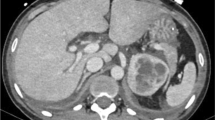Abstract
Purpose
The aim of this study was to assess the safety and efficacy of adrenalectomy on patients with pheochromocytoma diagnosed at the time of an acute heart failure (AHF).
Methods
We reported cases of patients who presented an AHF secondary to a pheochromocytoma during a period of 10 years. The diagnosis of AHF was defined by a left ventricular ejection fraction of less than 30 % or the use of circulatory assistance. They had adrenalectomy as emergency surgery or later. Morbidity and mortality of surgery were studied.
Results
Thirteen patients required an adrenalectomy for AHF secondary to pheochromocytoma. Four patients (31 %) had an adrenalectomy in emergency. Nine patients (69 %) had a delayed surgery with a median delay of 25 days (7–180). Eight patients had circulatory assistance (61 %). Five of them had a circulatory assistance and a delayed surgery (38 %), two of them had a circulatory assistance followed by emergency surgery (at 1.5 and 3 days) and one had emergency surgery immediately followed by circulatory assistance. Emergency surgery was performed by laparotomy in all cases and delayed surgery by laparoscopy for seven patients (54 %). Perioperative complications consisted in: one circulatory arrest, two bleedings requiring transfusion, one intestinal ischaemia, one haemoperitoneum with re-operation (day 8). One patient died on day 5. Post-operative course of patients with delayed surgery was uneventful.
Conclusions
AHF revealing a pheochromocytoma is a rare and serious event. Patients with emergency surgery have more complications than those with delayed surgery.
Similar content being viewed by others
References
Bravo EL (2003) Pheochromocytoma: state-of-the-art and future prospects. Endocr Rev 24(4):539–553
Plouin P-F, Gimenez-Roqueplo A-P (2006) Pheochromocytomas and secreting paragangliomas. Orphanet J Rare Dis 1:49
Yu R, Nissen NN, Bannykh SI (2012) Cardiac complications as initial presentation of pheochromocytoma: frequency, outcome, and predictors. Endocr Pract 18(4):483–492
Brouwers FM, Eisenhofer G, Lenders JWM, Pacak K (2006) Emergencies caused by pheochromocytoma, neuroblastoma, or ganglioneuroma. Endocrinol Metab Clin North Am 35(4):699–724, viii
Costa VM, Carvalho F, Bastos ML et al (2011) Contribution of catecholamine reactive intermediates and oxidative stress to the pathologic features of heart diseases. Curr Med Chem 18(15):2272–2314
Steppan J, Shields J, Lebron R (2011) Pheochromocytoma presenting as acute heart failure leading to cardiogenic shock and multiorgan failure. Case Report Med 2011:1
Iio K, Sakurai S, Kato T, et al. (2012) Endomyocardial biopsy in a patient with hemorrhagic pheochromocytoma presenting as inverted Takotsubo cardiomyopathy. Heart Vessels. doi:10.1007/s00380-012-0247-4
Bergland BE (1989) Pheochromocytoma presenting as shock. Am J Emerg Med 7(1):44–48
Feldman AM, McNamara D (2000) Myocarditis. N Engl J Med 343(19):1388–1398
Goldberg RJ, Samad NA, Yarzebski J et al (1999) Temporal trends in cardiogenic shock complicating acute myocardial infarction. N Engl J Med 340(15):1162–1168
Pagani FD, Lynch W, Swaniker F et al (1999) Extracorporeal life support to left ventricular assist device bridge to heart transplant: a strategy to optimize survival and resource utilization. Circulation 100(19 Suppl):206–II210
Sidebotham D, McGeorge A, McGuinness S et al (2009) Extracorporeal membrane oxygenation for treating severe cardiac and respiratory disease in adults: part 1—overview of extracorporeal membrane oxygenation. J Cardiothorac Vasc Anesth 23(6):886–892
Bos JC, Toorians AWFT, van Mourik JC, van Schijndel RJMS (2003) Emergency resection of an extra-adrenal phaeochromocytoma: wrong or right? A case report and a review of literature. Neth J Med 61(8):258–265
Salinas CL, Gómez Beltran OD, Sánchez-Hidalgo JM et al (2011) Emergency adrenalectomy due to acute heart failure secondary to complicated pheochromocytoma: a case report. World J Surg Oncol 9:49
Ritter S, Guertler T, Meier CA, Genoni M (2011) Cardiogenic shock due to pheochromocytoma rescued by extracorporeal membrane oxygenation. Interact Cardiovasc Thorac Surg 13(1):112–113
Goldstein DJ, Beauford RB (2003) Left ventricular assist devices and bleeding: adding insult to injury. Ann Thorac Surg 75(6 Suppl):S42–S47
Sidebotham D, McGeorge A, McGuinness S et al (2010) Extracorporeal membrane oxygenation for treating severe cardiac and respiratory failure in adults: part 2-technical considerations. J Cardiothorac Vasc Anesth 24(1):164–172
Chao A, Yeh YC, Yen TS, Chen YS (2008) Phaeochromocytoma crisis—a rare indication for extracorporeal membrane oxygenation. Anaesthesia 63(1):86–88
Huang J-H, Huang S-C, Chou N-K et al (2008) Extracorporeal membrane oxygenation rescue for cardiopulmonary collapse secondary to pheochromocytoma: report of three cases. Intensive Care Med 34(8):1551–1552
Wittstein IS (2012) Stress cardiomyopathy: a syndrome of catecholamine-mediated myocardial stunning? Cell Mol Neurobiol 32(5):847–857
Gatzoulis KA, Tolis G, Theopistou A, Gialafos JH, Toutouzas PK (1998) Cardiomyopathy due to a pheochromocytoma. A reversible entity. Acta Cardiol 53(4):227–229
Acknowledgments
The authors acknowledge FM. Beloncle and C. Dillon for the English correction
Conflicts of interest
None.
Author information
Authors and Affiliations
Corresponding author
Rights and permissions
About this article
Cite this article
Müller, G., Saint, F., Hamy, A. et al. Pheochromocytoma revealed by acute heart failure. When should we operate? Presented at the ESES Congress, Gothenburg May 25–26, 2012. Langenbecks Arch Surg 398, 729–733 (2013). https://doi.org/10.1007/s00423-012-1040-7
Received:
Accepted:
Published:
Issue Date:
DOI: https://doi.org/10.1007/s00423-012-1040-7




